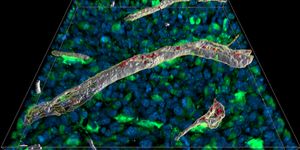Dual Treatment Regimen for Colorectal Cancer
Colorectal cancer (CRC) can develop in any part of the colon, the large intestine, or the rectum, the area of the body connecting the colon to the anus. Abnormal growths, known as polyps, can form in the colon or rectum. While initially benign, polyps can grow into cancer if left untreated.
Removal of polyps before they progress into CRC remains an effective preventative measure. Further, regular screening for CRC increases the chances of early diagnosis, where cancer better responds to treatment. However, according to the Centers for Disease Control (CDC), only about 70% of adults in the United States stay up-to-date on their CRC screening. Further, about 20% of adults have never received a CRC screen in their lifetime.
Currently, the five-year survival for CRC stands around 65%, but this statistic drops to 15.1% in those with late-stage diagnoses. Thus, new, effective treatment regimens remain a focus of ongoing cancer research.
Data presented at the 2023 American Society of Clinical Oncology (ASCO) Gastrointestinal (GI) Cancers Symposium last month suggests a novel combination immunotherapy approach has meaningful efficacy in treating advanced CRC.
The study tests the efficacy of combination therapy consisting of botensilimab (BOT) and balstilimab (BAL). BOT targets cytotoxic T-lymphocyte-associated antigen 4 (CTLA-4), an immune checkpoint that regulates the activation of T cells, the immune cells responsible for killing tumors. BAL binds a different immune checkpoint called programmed cell death 1 (PD-1), preventing the downregulation of the immune response. In combination, BOT and BAL could significantly strengthen the anti-tumor immune response.
The study, registered as NCT03860272, included 59 patients with metastatic CRC. The researchers reported the cohort as 58% female, averaging 57 years. Most (76%) patients in the study received three or more therapies before enrolling in the trial, indicating many hard-to-treat cases. Participants received BOT in combination with BAL.
The study evaluated several clinical endpoints, or statistical determinations, that help guide patient treatment plans. The study had an objective response rate (ORR), the percentage of the cohort exhibiting a partial or complete response, of 22%. Over 70% of participants showed disease control, indicating they achieved a response or stable disease. This clinical endpoint, known as disease control rate (DCR), suggests that most patients’ CRC did not further progress after receiving BOT plus BAL therapy.
In total, 13 patients had a response to the treatment, and 9 exhibited an ongoing response at the time of reporting. At 12 months, the trial demonstrated an overall survival (OS) rate of 61%. Treatment-related side effects occurred in most patients, but the most severe, grade 4 toxicities, including diarrhea and colitis, remained limited to less than 2% of the patients.
The authors conclude that metastatic BOT plus BAL therapy demonstrates durable efficacy in metastatic CRC patients. Notably, as the patients received multiple treatments before BOT plus BAL, the combination therapy appears promising in heavily pre-treated patients with difficult-to-treat cancers.
The researchers have already leveraged their findings to launch a phase 2 clinical trial currently enrolling patients.
Sources: ASCO, Am J Cancer Res









